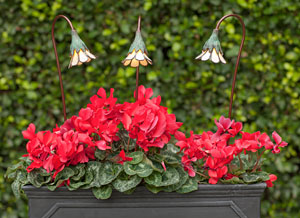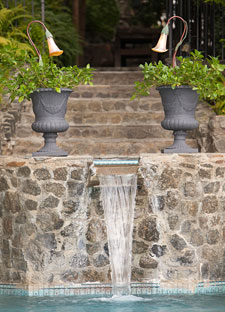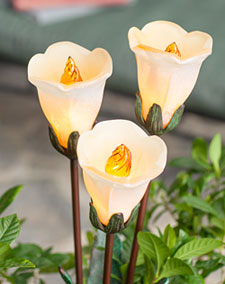The Great Illumination of Lance Lindsay's Stone Manor
 This buttercup trio with honey/opal glass, also available in yellow, well-exemplifies a lure of non-ferrous metals and bright light in the garden for night hours.
This buttercup trio with honey/opal glass, also available in yellow, well-exemplifies a lure of non-ferrous metals and bright light in the garden for night hours.Photograph courtesy of Stone Manor Lighting.
No stranger to starlight, copper artist Lance Lindsay has been capturing the attention of Hollywood A-listers, directors, set designers and collectors across the globe for the past 18 years with his handcrafted lighting and garden pieces.
Through his company Stone Manor Lighting, his compelling copper artwork has been featured on the hit TV shows Diagnosis Murder, Curb Your Enthusiasm, and Extreme Home Makeover, along with several television commercials, including spots for Martha Stewart and Ralph Lauren. Several notable celebrities have included his work at their shows and performances, including Billy Crystal, Bruce Springsteen, the Backstreet Boys, Crosby Stills and Nash, and more.
Having June Lockhart of Lassie fame as his stepmother and respected architect John C. Lindsay as his father has helped to draw people to see and appreciate the beauty of Stone Manor.
"Years ago, my wife wanted to have lights out in the gardens so people wouldn't trip while walking," explains Lindsay. "But the lights we bought eventually fell apart in just a few months, so I thought I could make my own-and better."
In those early days, Lindsay made his way around to different fabricating studios and welding shops in the region to learn more as he began to experiment with creating his own outdoor lights meant to keep paths clearly visible in the midst of darker hours.
But keeping it all interesting for the eyes easily became a part of the passion for Lindsay, as building and beckoning what's beautiful in his work has always strongly stemmed through his labors, no matter what the subject.
It helps, too, that his grandfather, grandmother and great-grandfather were all inventors, with his grandmother registering a patent for a safety pin, but unfortunately two months after another was in the works.
 Calla lilies in golden opal glass offer an easy explanation of why Lance Lindsay enjoys using sturdy brass with flower stems he creates.
Calla lilies in golden opal glass offer an easy explanation of why Lance Lindsay enjoys using sturdy brass with flower stems he creates.Photograph courtesy of Stone Manor Lighting.
An artistic and skillful lure is somewhat traceable in Lindsay's genetics. His great-grandfather also made furniture for the king of England, Lindsay notes. He later moved to the U.S. and began to work as a photographer.
Lindsay has design and utility patents on his tulip cluster sculpture. The unique persuasion of his pieces shines through not just the lighting in his works but of course in the colorful metal, too.
"The idea is to have a piece of art in the garden that lights the garden," he says. "So instead of lighting a piece of art, you have the art light the garden."
While many of his garden lights beam of gently bending flower-spent shapes, his 10-pound grandfather mushroom piece anchored into soil with a solid brass base and a quirkily peach-gold nearly wiggle-ready hand-blown glass top is the newest in his mushroom light line and is seeing phenomenal demand from those who have a strong penchant for seeking out his creations.
His original and still available line called the mushroom trio involves these fungi-lookalikes as a small, medium and large mushroom.
"They're very popular and I think it's because people like that it is totally unusual. With the orange, it looks like a poison mushroom with a little glow," he says. "It adds a warmth to the garden that you wouldn't normally get."
The lights he uses in his fixtures can last from three to eight years, he says, but he's also had some say their light bulbs needed no replacing for 10 or even 12 years straight.
"Some people have been collecting these lights for years," Lindsay admits. "Some even have the original ones I first made almost 20 years ago, and each year, they buy more."
In fact, a portion of his clientele is known to arrange flights to California just to visit his gardens to see what is new in his light-crafting, Lindsay explains.
His inventory usually incorporates flower lights, garden lanterns, estate lights and lanterns, even address boxes, sconces, chandeliers, flower lamps and rain chains.
 The copper evening primrose design with a rubbed bronze finish is sometimes done in a patina finish.
The copper evening primrose design with a rubbed bronze finish is sometimes done in a patina finish.Photograph courtesy of Stone Manor Lighting.
In the first few years of Stone Manor Lighting's existence, those who gravitated to Lindsay's outdoor lighting fixtures with almost a magnetic captivation of sorts enjoyed the illumination so much that they told him they started to use them indoors on a regular basis. His outdoor-intended lights began to find their way into dining rooms, bathrooms, hallways and kitchens of his clientele, he says. This inspired Lindsay to shift part of his focus to creating indoor lights, which take a lot of acclaim from those who are so enthusiastic for the work that stems from his mind and hands.
And his brass and copper rain chains, inspired by the idea of similar yet more basic ones known deep into the past in Japan and the Middle East, are a unique replacement for a downspout while carrying a whimsical way with flowers whose petals he aims upward, always reaching for the sun.
Lindsay says he uses copper most frequently in his works which do often share brass and bronze components in final designs. He sources sheet metal from Coast Aluminum and Architectural, with its Southern California location based in Santa Fe Springs, piping for delicate wire from Smardan Supply Company in El Monte, California and brass reducers from Liberty Brass Turning Company in Long Island City, New York.
For his bronze work, Lindsay uses various foundries around his region.
"First I have to see it in my head, and then I can make it," Lindsay explains of his process with any lighting piece. Some of his resources in his studio are dentist tools. "But I'm always inventing tools, too."
He considers his labors with Stone Manor Lighting to be somewhat in line with art nouveau in his stylistic inspirations.
"Art nouveau to me is nature that's been bent and pulled," he says. "It's a style, and art nouveau was hugely popularly in the 1920s and for a while afterward. It's kind of eclectic in the sense that it keeps coming back into style and goes with craftsman houses, really old houses and even modern houses. It's like nature with a twist. And the curves of these leaves and petals-they have grace," Lindsay adds.
The possibility of colors is what Lindsay appreciates most about copper, along with the fact that it doesn't rust.
"I like brass for its strength and often use it to reinforce the inside of a lamp," he admits. "I also like brass for certain kinds of stems. And copper bends more easily, but again, I like the color of copper more because it has a beautiful patina when it ages."
Throughout his years creating so many magically charm-equipped lights for both the indoors and outdoors, Lindsay estimates that he built thousands of different illumination-ready pieces in his history.
"Some of the sconces are in Greystone Mansion in Beverly Hills, a famous house where millions of films have been made," Lindsay says about the reach of his works on a local level. "A bunch of the sconces are in the grand entry hall."
Lindsay was also recently asked to be a part of the 2012 Philadelphia Flower Show, an invitation-only event for vendors.
"We're too busy to do more shows than this," he says, "but we love Philadelphia because we have so many fans there."
Resources:
Also in this Issue:
- The Great Illumination of Lance Lindsay's Stone Manor
- Copper Spawns New Artistic Pursuit
- John Searles: Original, Vibrant, Abstract Metal Sculptures
- Leslie Neidig Designs: Folding Copper Into Unique Jewelry
- Gravity and Grace: Monumental Works by El Anatsui on view at Brooklyn Museum
